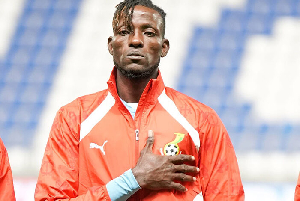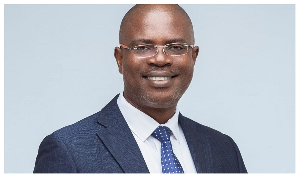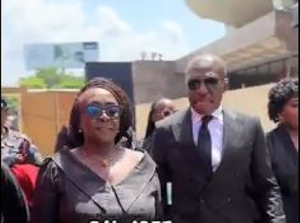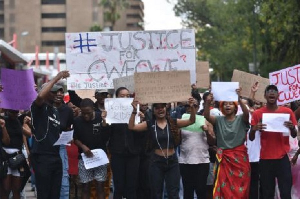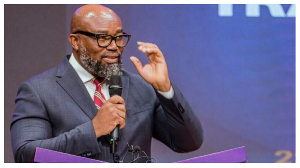It is quite important for historians and students of history, more so the general public to be given the right information especially where conflict and misunderstanding erupts especially on chieftaincy matters. It is therefore relevant that one takes a very neutral stand in an attempt to tell the tale as it is, since balancing the facts for public consumption will in very many respects heal the entire process. Ghanaians always yearn for the truth and nothing more. This piece seeks to set the record straight for the sake of posterity and the good people of Ghana in connection with the recent Nanung chieftaincy issue.
There seem to be no end in sight to the distortions that have characterised the Bimbila chieftaincy dispute and several attempts to straighten the records have proved a difficult task to be fulfilled. Some commentators have continuously attempted to rewrite the history Nanung, a task which so far proved impossible to achieve. It is in this direction that a bold attempt needs to be taken to set the records straight any time the facts of the Bimbila chieftaincy dispute erupts with seeming distortions by commentators. Some have even sought variously to misinform the reading and listening public, by resorting to half truths and untruths about the statuses of Salifu Dawuni and Naa Andani Dasaana Abdulai with regards to the Bimbila nam, claiming that “Nanumba Royals should not access the paramountcy straight away, but through a succession and promotion steps in order to reach the final hierarchy of the chiefdom through a ‘promotional ladder’ beginning from a lower chiefdom”. The assertion that a Nanun royal can only become chief of Bimbila through the ‘promotional ladder” is an utopian situation and will not apply in all conceivable situations. By the use of the word ‘utopian, those who writes untruths about Nanung issues admits that there have been situations where the ‘promotional ladder’ was not used, or it was not required at all. In the annals of Nanung history, it has been recorded and affirmed that Naa-Sulgme, Naa-Dagiporiga, Naa-Goyembah, Naa-Salifu, etc did not have to follow the ‘promotional ladder’ before they became chiefs of Bimbila. Even the Yani Skin (Yendi Skin) which by tradition among the Gbewa family is senior to the Bimbila Skin and shares the same culture and tradition is known to have had princes who used their bare names to ascend the Yani Nam. The example in the Yani nam case that readily avails itself for mention is the enskinment of Naa-Bamberg.
Reasons for saying that rising through the ‘promotional ladder’ to become chief in Bimbila can only work in an ideal situation are not farfetched. For instance, the ‘promotional ladder’ rule cannot apply in a situation where a pretender who does not qualify to become chief by tradition, custom and law manoeuvres his way through to the top with the influence of money and supposed “powerful people”. This observation constituted one of the reasons for the Nayiri’s rejection of a particular chief’s bid for the Bimbila Skin. It will not also apply where a particular royal gate taking its turn to the Bimbila Nam has no sitting chief in any of its villages. Nanung chieftaincy will grind to a halt as soon as there will be no prince from both royal gates who would have risen through the ranks.
It is not impossible for a royal gate to have no sitting chief at the time it is called upon to take its turn to the Bimbila nam, is it? At the time Naa Andani was enskinned, there was no chief from the Gbugmayili side in any of the villages. Naa Andani was also at the time the eldest surviving son of his father, Bimbila Naa Dasaana and had the blessing of his uncles and the core elders of the Gbugmayili family to take over the mantle of Bimbila chiefship. He was therefore conferred with the title of Kampakuya Naa and installed as such. Are the Bangyili family saying that if the chieftaincy is passed on to Bangyili today the gate will not install a chief on the basis that none of their princes, as it were, is a sitting chief? The only person in Gbugmayili with the semblance of a chieftaincy title in 2003 when Naa Andani was enskinned was Salifu Dawuni whose very claim to the Nakpa skin was in contention because of his matrilineal lineage to the Gbugmayili gate, and whose claim in any case was being contested at the Northern Regional House Chiefs. It has always been a hidden agenda of certain individuals from the Bangyili royal gate, albeit unpopular, to paint the picture that Gbugmayili had disrespected Naa Abarika Attah when he was chief of Bimbila. This is not true. The people who profited from the seeming conflict between Gbugmayili and Naa Abarika will tell all the stories they want in order that they can continue to benefit from their mischief, but the facts on the ground does not support their claim. Indeed, Gbugmayili graced the funeral of the late Naa Abarika Atta with pomp and pageantry even in the face of open hostilities that were meted out to them at the funeral grounds.
Salifu Dawuni has lost many petitions and court cases he petitioned or filed against Naa Andani (e.g, the Damango peace accord, the Nayiri arbitration, the petition before the Northern regional house of chiefs, etc Salifu Dawuni was related to the Gbugmayili royal gate through his great grandmother and that the Bimbila Skin is not one of the skins female lines can inherit. It is also certainly not a skin a great grandson can occupy.
Then again, these people's grievance, probably more appropriately their excuse against the performance of Naa Andani’s funeral as the chief of Bimbila exposes a self-serving logic when juxtaposed with their present position on the legitimacy of Salifu Dawuni to the Bimbila Skin. They intimates that “in the books of the courts, there is no substantive king in Bimbila”, their reason being that the matter is pending on appeal. They have however admitted that the petition against Salifu Dawuni’s enskinment as chief of Nakpa is equally still pending before the Regional House of Chiefs. But true concerned citizens of Nanung would love to write about it because it adds impetus and legitimacy to Naa Andani’s claim to the throne. Since they are equally such a great fan of justice and democracy, it is not thought it will hurt in any way restating that long and winding legal history that sets out Naa Andani way above Salifu Dawuni even in Naa Andani’s seeming defective claim to the throne.
On 10th February 2004, Salifu Dawuni and Juo Regent petitioned the Northern Regional House of Chiefs against Naa Andani, contending that he, Salifu Dawuni was the rightful person to occupy the Bimbila Skin as Bimbila Naa. After eight long years of hearing, the Northern Regional House of Chiefs proclaimed the late Naa Andani the rightful person to occupy the Bimbila Skin as Bimbila Naa. Even before the petition to the Northern Regional House of Chiefs, Salifu Dawuni had petitioned the paramount chief of Mamprugu, the Nayiri, who is the customary arbitrator of Nanung chieftaincy disputes. The outcome of that arbitration was that Naa Andani was the rightful occupant to the Bimbila Skin. There were other pockets of petitions and court actions, all at the instance of Salifu Dawuni which all went the way of Naa Andani. The Northern Regional House of Chiefs’ 13th March 2012 verdict in favour of Naa Andani advanced myriad of reasons for the Committee’s decision.
This holding of the committee without anything more, put to an end whatever claims Salifu Dawuni might have had to the Bimbila skin. Salifu Dawuni even appealed to the Supreme Court for the restoration of the order of the Nanumba Traditional Council and lost. A cost of GHC 2,000(then twenty million cedis) was awarded against him in favour Naa Andani Dasaana. And it has yet to be paid. Let the whole world know that in addition to the doubts already cast on Salifu Dawuni’s qualification, the High Court quashed the Nanumba Traditional Council’s ruling that sought to confirm Salifu Dawuni as the legitimate candidate for the Bimbila skin. Everything that the Bangyili and Salifu Dawuni have done so far is in sharp contrast to the cry of peace they stand for. The committee said that three kingmakers opted for Salifu Dawuni as against six who opted for Naa Andani, and that the three kingmakers who purported to enskin Salifu Dawuni did not include the Kpatihi who is entitled to confer the title on Bimbila chiefs.
The people of Bimbila are yet to come to terms with the logic that has led some citizens of Nanung to the conclusion that it is fair to make Salifu Dawuni chief of Bimbila because “as many as” three kingmakers nominated him, knowing that as many as six kingmakers on the other hand enskinned Naa Andani.
There is no one from Gbugmayili outside the immediate family of Salifu Dawuni who supports Salifu Dawuni. Indeed, the late Suga Naa, his own biological elder brother (same father and mother) did not support him and actually held several press conferences in which he dismissed him as a pretender. In the first place, the genesis of the problem comes from the installation of Nakpa Naa by Naa Abarika Attah and concludes that “naturally, [Bangyili] cannot disrespect the decision of late Bimbila Naa. That explains why the conflict is still dragging all these years Perhaps some concerned citizens of Nanung do not know that while Nakpa Naa’s petition against the installation of Naa Andani was pending at the Northern Regional House of Chiefs, Bangyili, led by the Dokpam Sabnaa applied to be joined to the petition and their application was thrown out. They may not also know that Vonaa Abarika Attah, the regent of Naa Abarika Attah, went to Kumasi as part of the five man delegation representing the petitioner (Salifu Dawuni) when the National House of Chiefs invited the petitioners and the respondents to Kumasi. Some concerned citizens of Nanung do not know that Mr. Ziblim Nantogmah and Vonaa presided over meetings that discussed the burial of the late Salifu Dawuni, or that Vonaa has led the Bangyili youth on several occasions to promise fire and brimstone over what they saw as a delay in the burial of Salifu Dawuni as Bimbila Naa. The realization is that it is Bangyili that is fighting Gbugmayili, not Salifu Dawuni. It is therefore an attempt to throw dust into people’s eyes of all that it is an intra-gate affair!
They have been very economical with the truth in many respects and the one that stands out most is that the family of Salifu Dawuni wanted to bury him as Nakpa Naa in his house at Bimbila but were denied. Salifu Dawuni has no house in Bimbila, and if he does, it is certainly not the house he was going to be buried in as the house was built by Naa-Abdulai, the direct grandfather of Naa-Andani. Reasons are to be provided why they wanted to bury him at Bimbila and not Nakpa. The family claimed that he had no house in Nakpa even though the Gbei Naa’s palace is the house of every Nakpa chief. If he could not be buried at Nakpa because he had no house there, why would it be prudent to bury him in Bimbila instead, where he equally has no house? Besides this, his family has written several letters to request Salifu Dawuni’s body for burial as Bimbila Naa. It is therefore not true to claim that he was denied burial as Nakpa Naa. It beats the imagination of many that some concerned citizen of Nanung would seek to justify the murder of a fellow Nanumba for the reason that people teased the family of Salifu Dasaana who died of natural causes. But with this precedence and affirmation of its propriety, Nanung is in for a long haul because people will always tease people for one reason or another, and there will always be chiefs. One cannot speak for Gbugmayili or the law enforcement agencies with respect to the arrests of those invited for questioning. What is known is that those arrested will be released if they were not involved in the murder. Even the family of Naa -Andani does not wish that innocent people are punished for crimes they did not commit. They want the real culprits to be punished.
Let us all pray and hope that for once in this country, our justice system can rise to the occasion and halt this culture of killing chiefs with impunity so as to preserve the noble and time-tested institution of chieftaincy. This will go a long way to assure the people of Nanung and Ghana as a whole of the peace we all so much desire.
Abdul Hanan K.Dasana P.O.Box 182, Bimbila. Northern Region Email: abdulhanank.dassana
Opinions of Sunday, 10 August 2014
Columnist: Dasana, Abdul Hanan K




